How to install a kitchen splashback – protect your walls in seven easy steps
Don’t leave your walls at the mercy of spillages and stains when an easy-clean splashback can take the strain. Here’s how to fit your own

Designed to protect the walls directly above worktops, kitchen splashbacks are a great choice for busy family homes. With no grubby grout to clean, splashbacks are lower maintenance than tiles, and they also bring a lot to the party in terms of colour and design interest. Plus by learning how to install a kitchen splashback yourself it can be done on a budget!
While it’s not necessary to clad every inch of wall in splashback, you should definitely consider targeting the areas above the cooker and sink. This is where walls most come under fire from oily splashes and water damage. Used this way, in moderation, a stylish kitchen splashback idea can act as a focal point, drawing attention to an attractive cooker or designer sink.
How to install a kitchen splashback
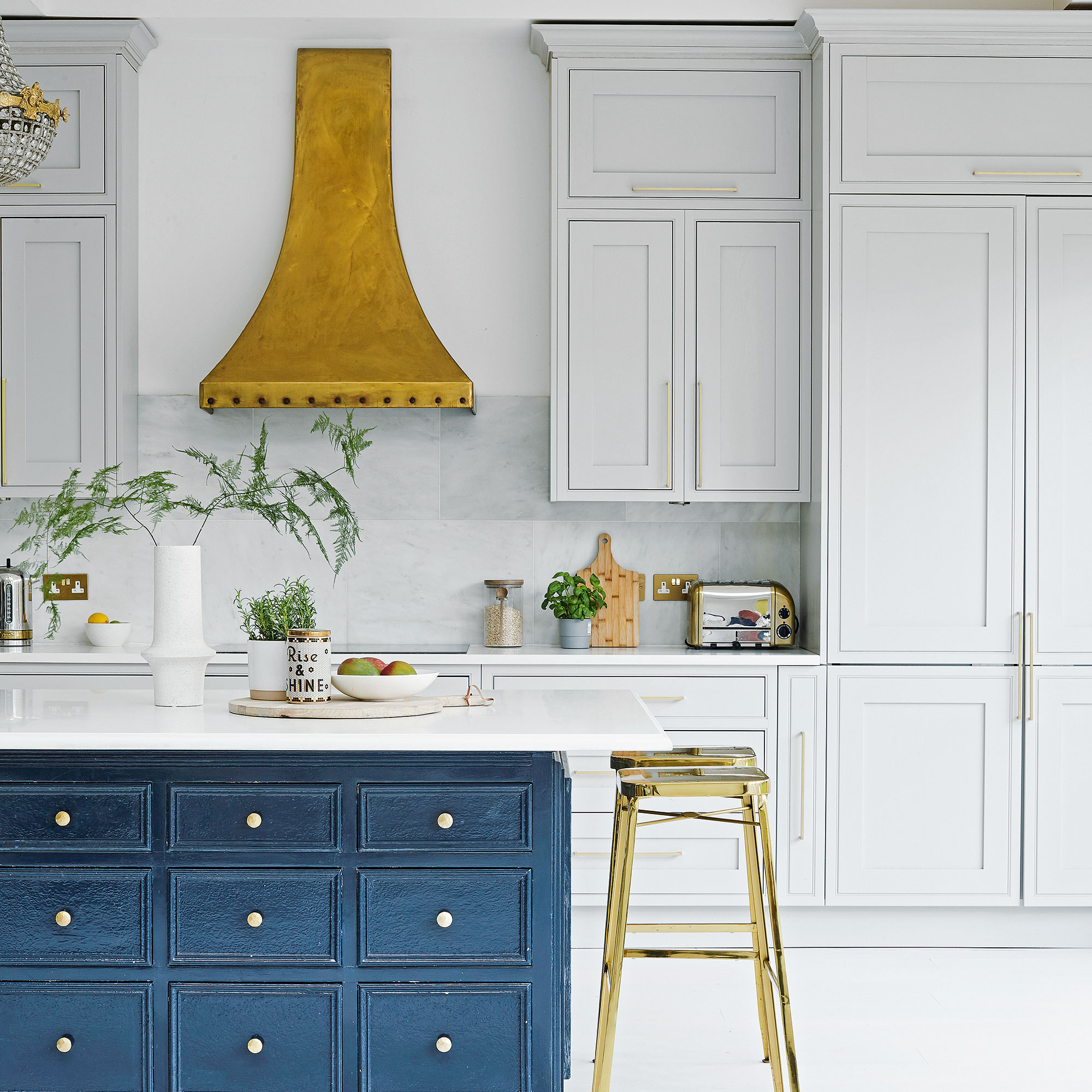
Kitchen splashbacks are available in various materials but the most popular for DIY installation are made from glass (including mirrored glass), acrylic, laminate, stainless steel and other sheet metals, like brass and copper. Additional kitchen wall ideas worth exploring include panelling, tiles and even vinyl wallpaper.
Always make sure you read the installation instructions before you buy a splashback, so you know what you are letting yourself in for and can get prepared with any tools or adhesives required.
Take special care to check that the material you want to use is suitable for where you want to install it; some splashbacks are not designed to be used directly behind a gas hob for instance. Discover how to fit a kitchen splashback with our easy-to-follow guide.
1. Prepare the surface
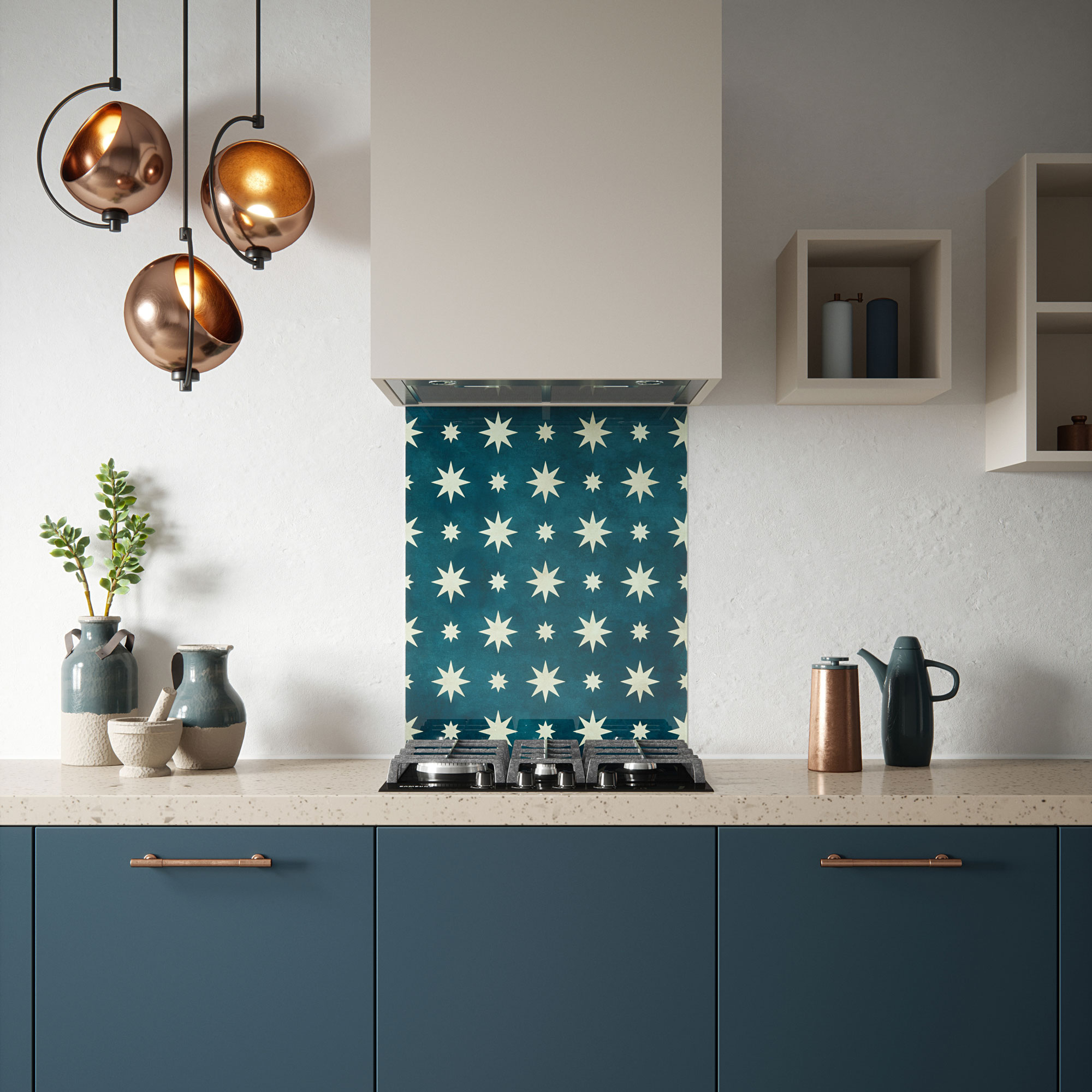
Good preparation is everything. Time spent getting this first essential step right will pay dividends when it comes to attaching the splashback to your wall – and keeping it there! ‘It doesn’t matter what type of material you choose for your splashback, the surface you’re putting it on has got to be flat, non-porous, dry and dust free,’ advises Claire O’Brien, head of design at Splashback.
The amount of effort required will depend on the current condition of your walls. If you have removed old tiles or ripped off a splashback panel, you may need to level any holes with filler. The surface needs to be non-porous, so that it won’t suck up the adhesive. Fresh plaster will benefit from a thin coat of PVA or primer.
Check the surface is flat using a spirit level or length of timber. Uneven surfaces can cause splashbacks to crack, especially those made from glass or acrylic, and can result in wonky gaps around the edges of any splashback.
2. Mark out the splashback position
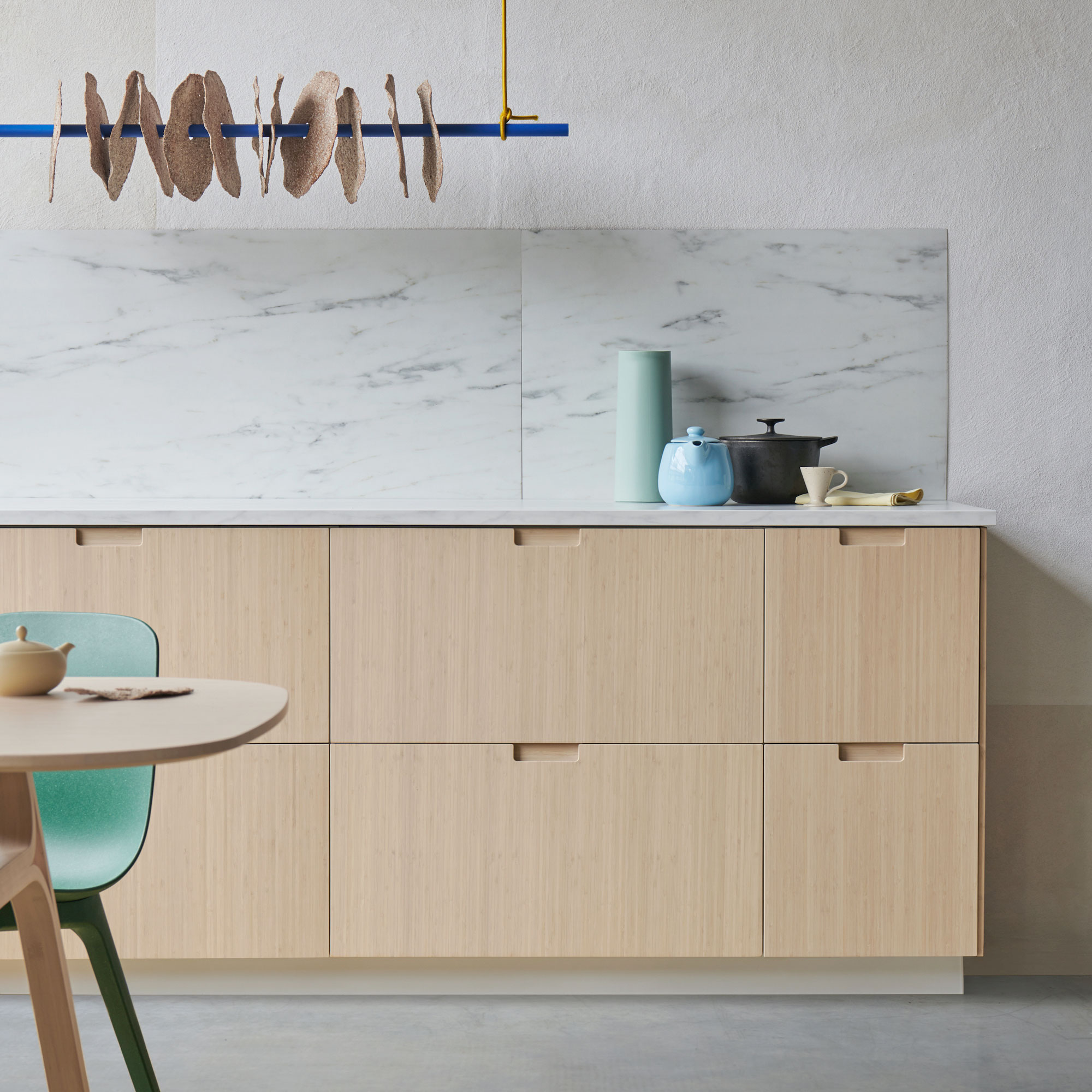
Next plot out and mark the exact position you want to put your splashback on the wall. A single splashback panel should be carefully centred on the sink or cooker it is positioned above. If you are going full width with your splashback, and can do it in a single panel, it’s only the height you need to mark out. Don’t forget to use a spirit level to make sure your positioning is straight.
Allow a 2mm gap around the splashback for expansion and sealant. Pay special attention to the distance between a hob/cooker and the splashback to avoid heat damage. Aim for at least 11cm between the hob and splashback for a gas hob, and 10cm for electric, but do check for any special instructions that apply to your chosen splashback.
3. Cut the splashback to size
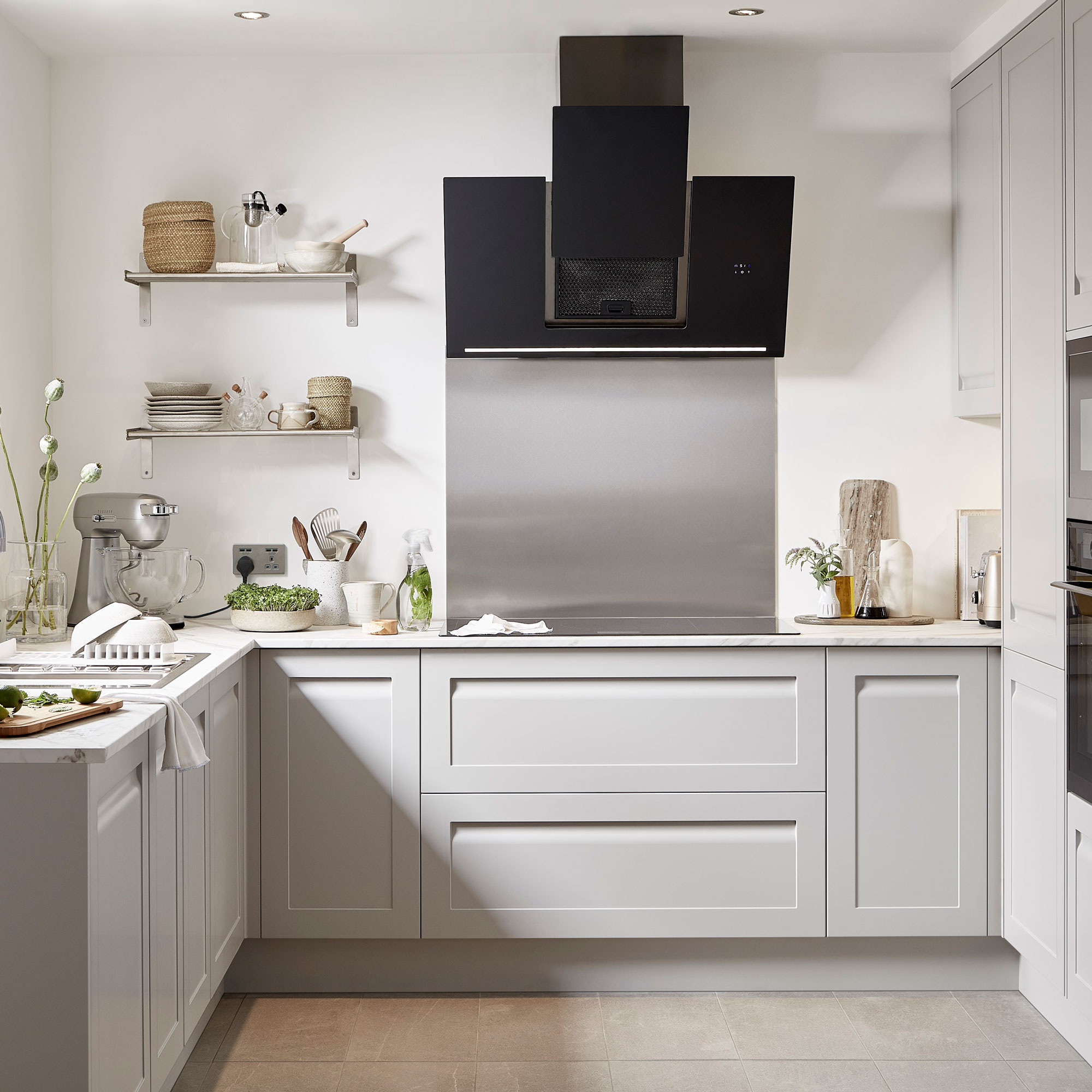
The easiest route is to buy custom-cut splashbacks that are cut to your specific measurements before they arrive! Or you can buy standard size splashback panels in a vast range of sizes, which will also allow you to skip this step. The most popular readymade splashback panel sizes are 60cm x 75cm, 90cm x 75cm and 100cm x 75cm.
Acrylic, laminate and thin sheet metals like aluminium and copper are the best options if you are determined to cut your own splashback to size. Use a fine-toothed blade that’s designed for plastics or aluminium. You may need to buy a circular saw or other specialist power tool to achieve a neat finish. Always ask your supplier for advice.
‘Mark out the dimensions on your splashback of choice before laying on a workbench. Add tape to the edges of where you will be cutting to avoid chipping the material. We also recommend laying your splashback on a soft material to avoid damage and ensure you’re wearing the necessary protective gear when working around any sharp tools,’ says Paul Bangs, Wickes’ Category Director for kitchens.
Then sand down the cut edges with a cork sanding block and 240 grit sandpaper. Always keep any protective film on the front of the splashback while you work.
Cutting stainless steel and glass splashbacks is generally best left to the professionals, as it requires expensive, heavy-duty tools for perfect results. Regardless of who cuts your splashback, always do a dry fit to ensure you are happy with the size and position – checking it doesn’t catch on any surrounding cabinets.
4. Apply adhesive
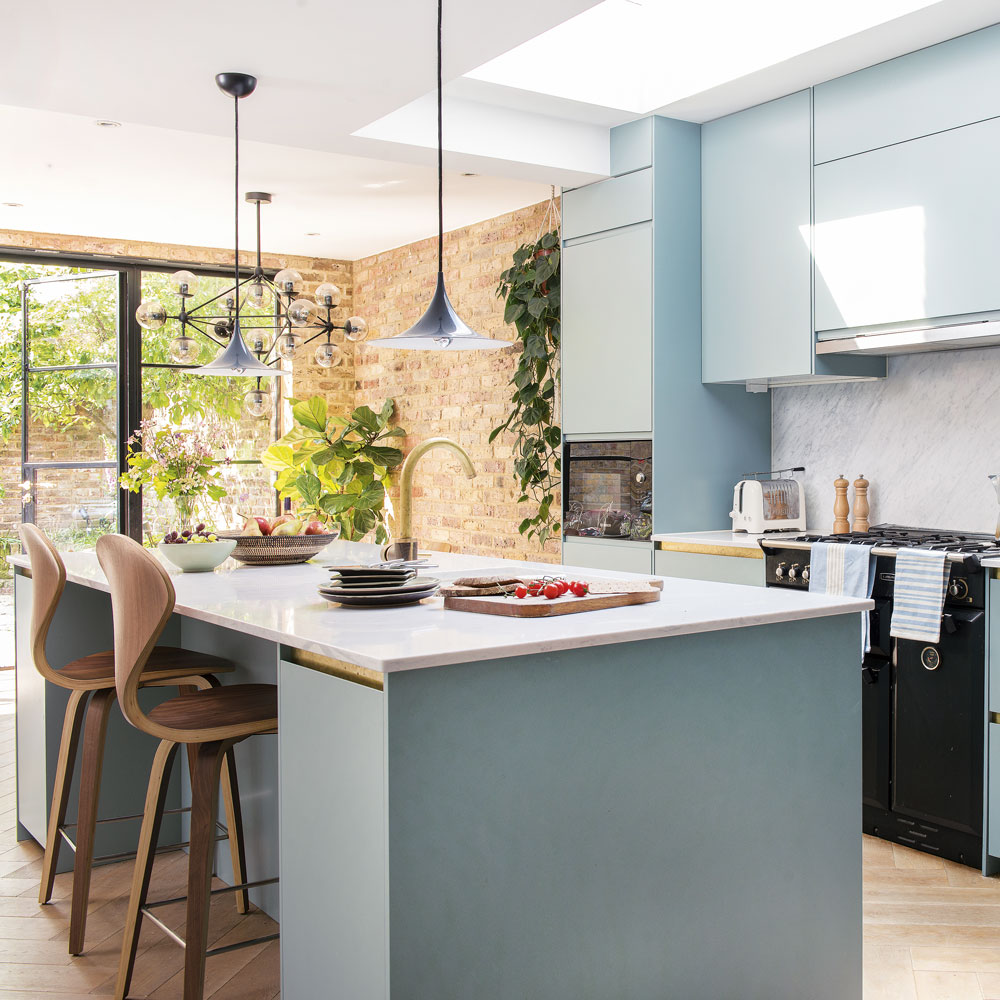
While some heavy or out-sized splashbacks require screws for a firm fixing, the most popular way to attach regular glass, metal and other sheet-style splashbacks is by using a combination of double-coated foam tape and low modulus silicone adhesive. You can also buy splashbacks with pre-applied sticky backing that skips the need for extra adhesive.
First apply strips of foam tape to the top, bottom, sides and middle of the back of your splashback, taking care not to overlap. Then, using a silicone gun, apply adhesive in the areas between, in a wavy pattern, again avoiding overlap. There’s no need to go crazy, just aim for even coverage with 2-3cm wide gaps between.
5. Fix the splashback to the wall
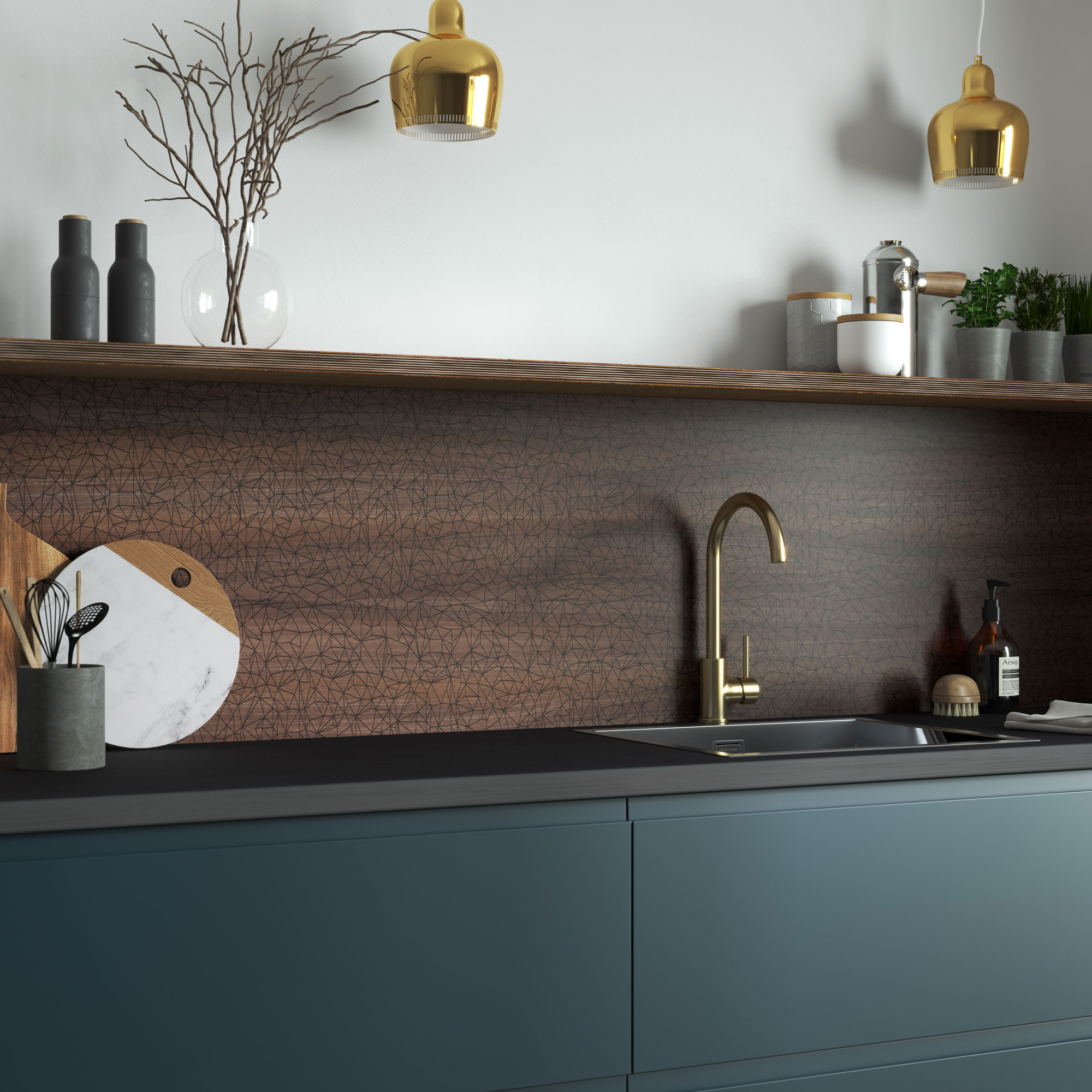
Remove the protective strip from the foam tape and firmly attach the splashback onto the wall, using your positioning lines for guidance. Apply gentle pressure evenly across the splashback, and check it is straight using a spirit level.
‘Once it's adhered to the wall, remove any visible gaps by sealing around every edge with the adhesive, then remove any excess to finish,’ adds Paul Graham, installation expert at Bushboard. Use masking tape to hold the splashback in position while the adhesive sets – at least 24 hours but check the label on your adhesive for guidance.
Once the adhesive is cured, peel away any protective film from the front of the splashback and wipe it down with a clean, damp cloth.
6. Seal the joints
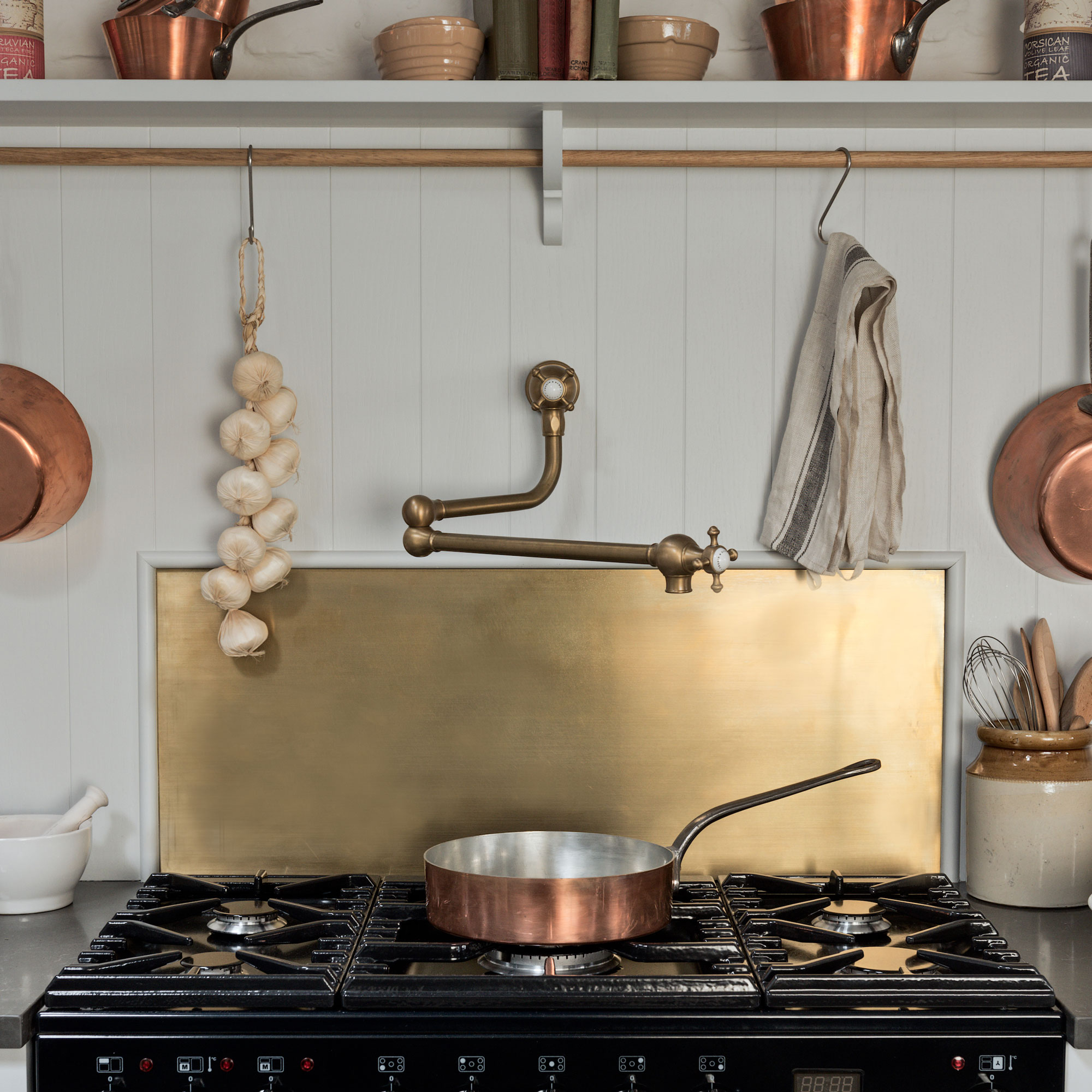
When the adhesive is completely cured and the splashback is firmly attached with no movement, remove any masking tape used and apply a thin line of silicone sealant – no more than 2.5mm thick – around the edges. Take special care at the joint between the splashback and worktops as you don’t want any major spills to get down the back of the cabinets. Do use a bathroom or kitchen grade silicone to ensure a watertight seal and help prevent mildew stains.
If your edges are not as neat as you’d like, or you want to add a little extra definition, consider framing the splashback with off-the-shelf trimming strips. ‘Framing a splashback panel draws attention to the material, making it feel extra space and also helps create a really tidy connection between the splashback and wall,’ says kitchen designer, Charlie Kingham.
7. Add a protective finish, if required
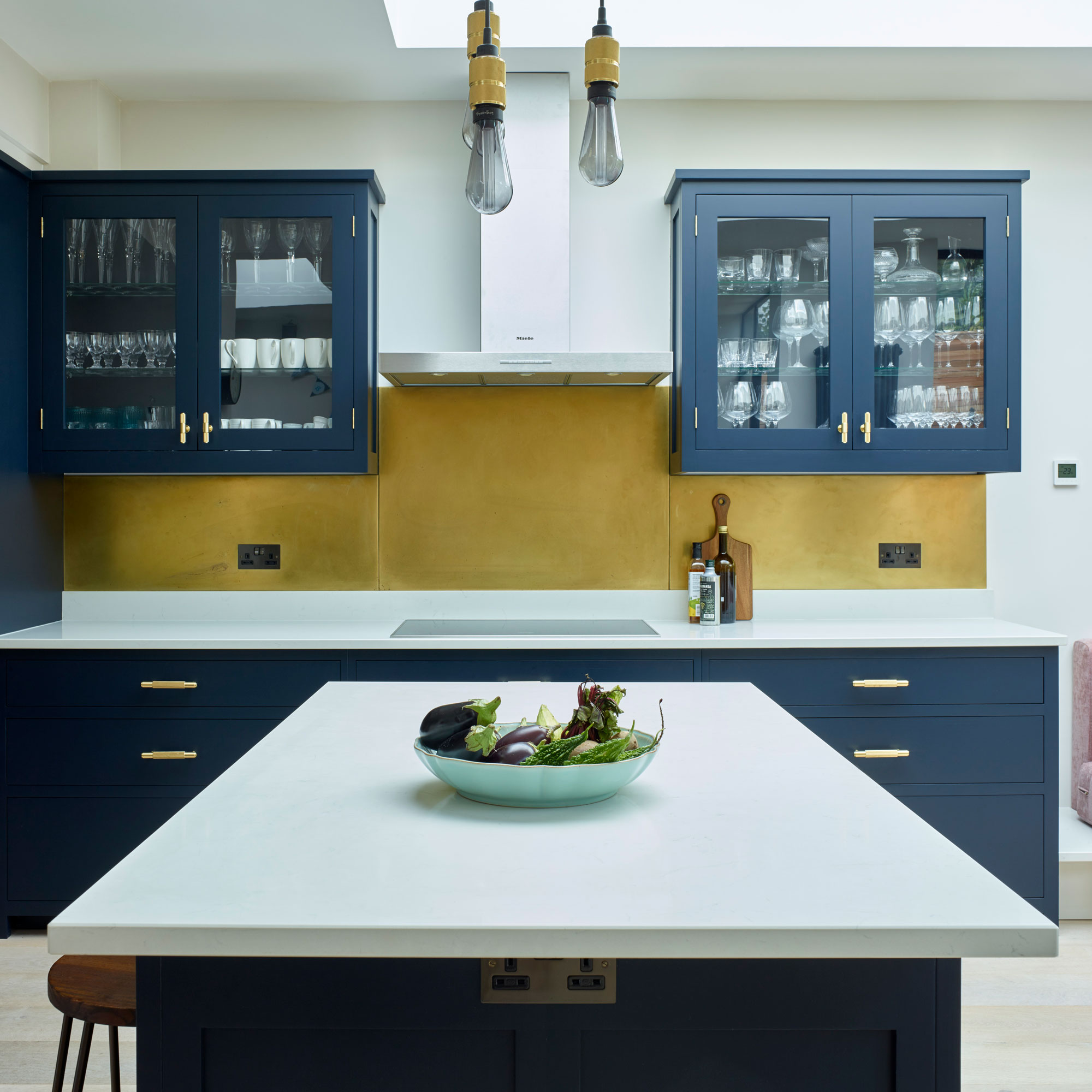
Splashbacks made from glass, acrylic, stainless steel and laminate won’t need any further treatment to protect them from splashes and spills. However, if you are installing on-trend warm metallic splashbacks made from brass, copper or bronze sheeting, you might choose to apply a coating of sealant. ‘Brass and copper splashbacks are beautiful but it’s important to understand how reactive they are,’ says kitchen designer, Ben Hawkswell, of Roundhouse.
Direct exposure to moisture will alter the appearance and a mottled patina will gradually form in time and use. Some people love the aged look but if it’s not for you, either buy ready-sealed metal splashbacks or apply a thin layer of metal lacquer using a fine foam paint roller.
Are kitchen splashbacks easy to fit?
While it’s true that not all splashback materials are suitable for novice installation (for example fabricated surfaces like composite quartz and other stones), there are plenty of options aimed at keen DIYers.
You can make life a lot easier for yourself by buying splashback panels that don’t need to be cut. However, there’s plenty of companies now offering custom cutting services using your own dimensions or templates, including cut-outs for switches and sockets, as well as a wide range of readymade sizes held in stock.
Acrylic and laminate splashbacks are arguably the easiest to install yourself because they are lightweight, thin and are often supplied with self-adhesive backings.
What are the easiest splashback panels to fit DIY?
‘Aluminium panel splashbacks are straightforward to install by any homeowner who is both confident making basic DIY updates and inclined towards carrying out projects at home. Splashbacks made from aluminium panels can be easily cut, drilled and shaped to fit required measurements using standard tools,’ says Paul Graham, installation expert at Bushboard.
‘Purpose-made laminate splashbacks are another great option for creating a sleek, uniform look when paired with a worktop in the same finish. Installation requires slightly more preparation and skill. However it’s certainly a job that a competent DIY enthusiast could carry out independently, without expert help.’
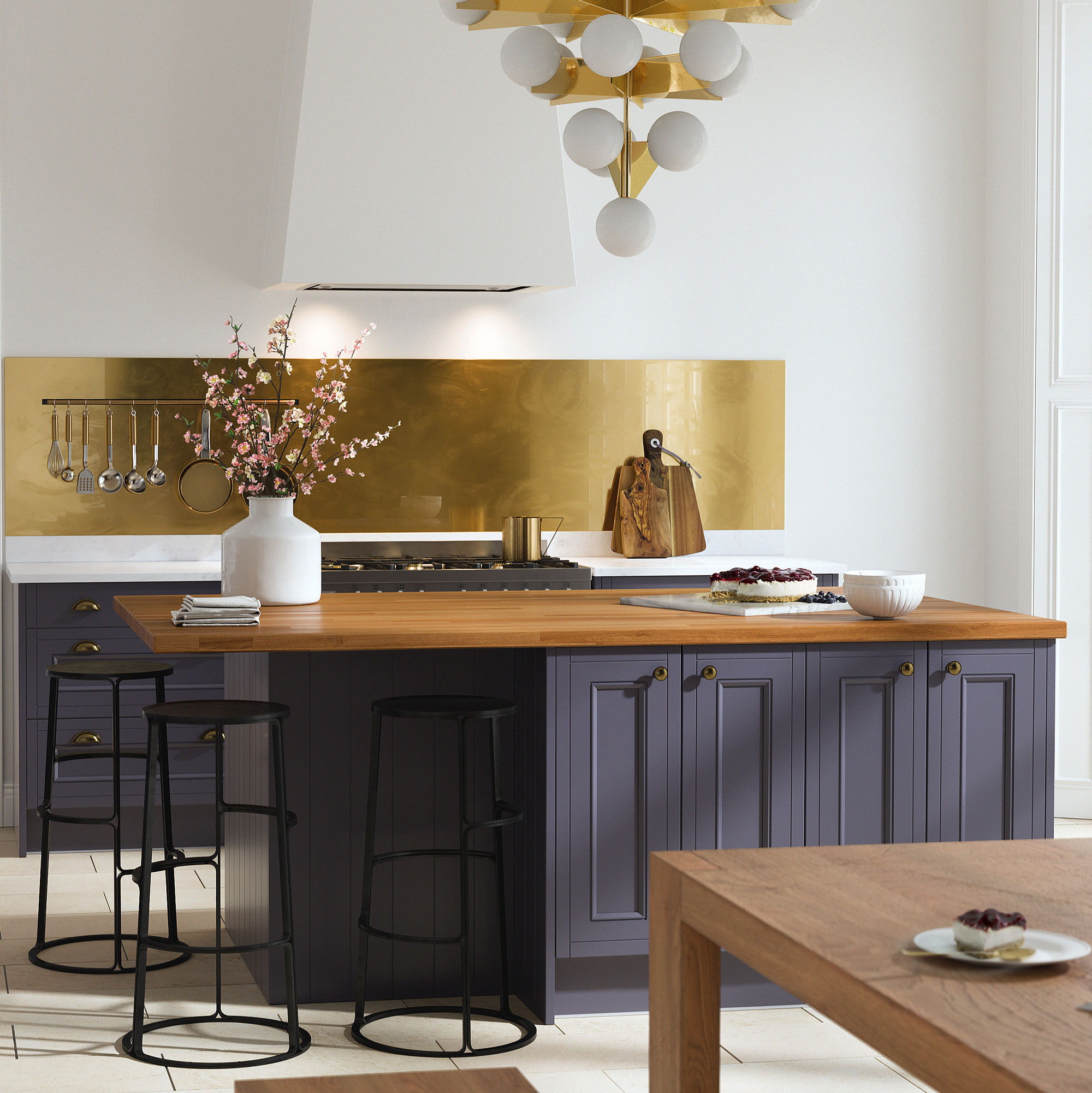
How can you avoid joint lines when fitting a splashback?
‘Splashbacks are commonly available in a variety of dimensions, so in the first instance, I’d recommend choosing a size that best fits your space. However sometimes, particularly in larger areas, joining two panels is an inevitability,’ says Paul Graham, installation expert at Bushboard.
The best joining option depends on the material. Some metal splashbacks are available with specialist jointing plates that help achieve a neat connection. Otherwise, it’s a case of butting the panels as close together as possible and using a clear or colour-matched silicone to create a watertight seal.
How do you stick a splashback to the wall?
To stick a splashback to the wall you can use two options. The first, and neatest because there are no visible fixings, is adhesive. Some splashbacks will adhere with double-sided sticky tape only, but most require a combination of silicone sealant and tape to help hold the splashback firmly in place while the silicone dries.
Do read the installation instructions supplied with your splashback with regards to the type of silicone that will work best but, generally, a Low Modulus sealant (a.k.a. low mod) is preferred because it is slightly stretchy and can handle more movement than rigid High Modulus options.
The second way to stick a splashback to the wall is using screws. In which case your splashback should come with pre-drilled holes and the requisite screws and rawl plugs. If you can put up a shelf, you shouldn’t have any trouble screwing a splashback to the wall. The most important thing to remember is to not overtighten the screws. Use rubber washers if possible. Overtightening can crack or damage a splashback.
Get the Ideal Home Newsletter
Sign up to our newsletter for style and decor inspiration, house makeovers, project advice and more.

Linda Clayton is a professionally trained journalist, and has specialised in product design, interiors and fitness for more than two decades. Linda has written for a wide range of publications, from the Daily Telegraph and Guardian to Homes & Gardens and Livingetc. She has been freelancing for Ideal Home Magazine since 2008, covering design trends, home makeovers, product reviews and much more.
-
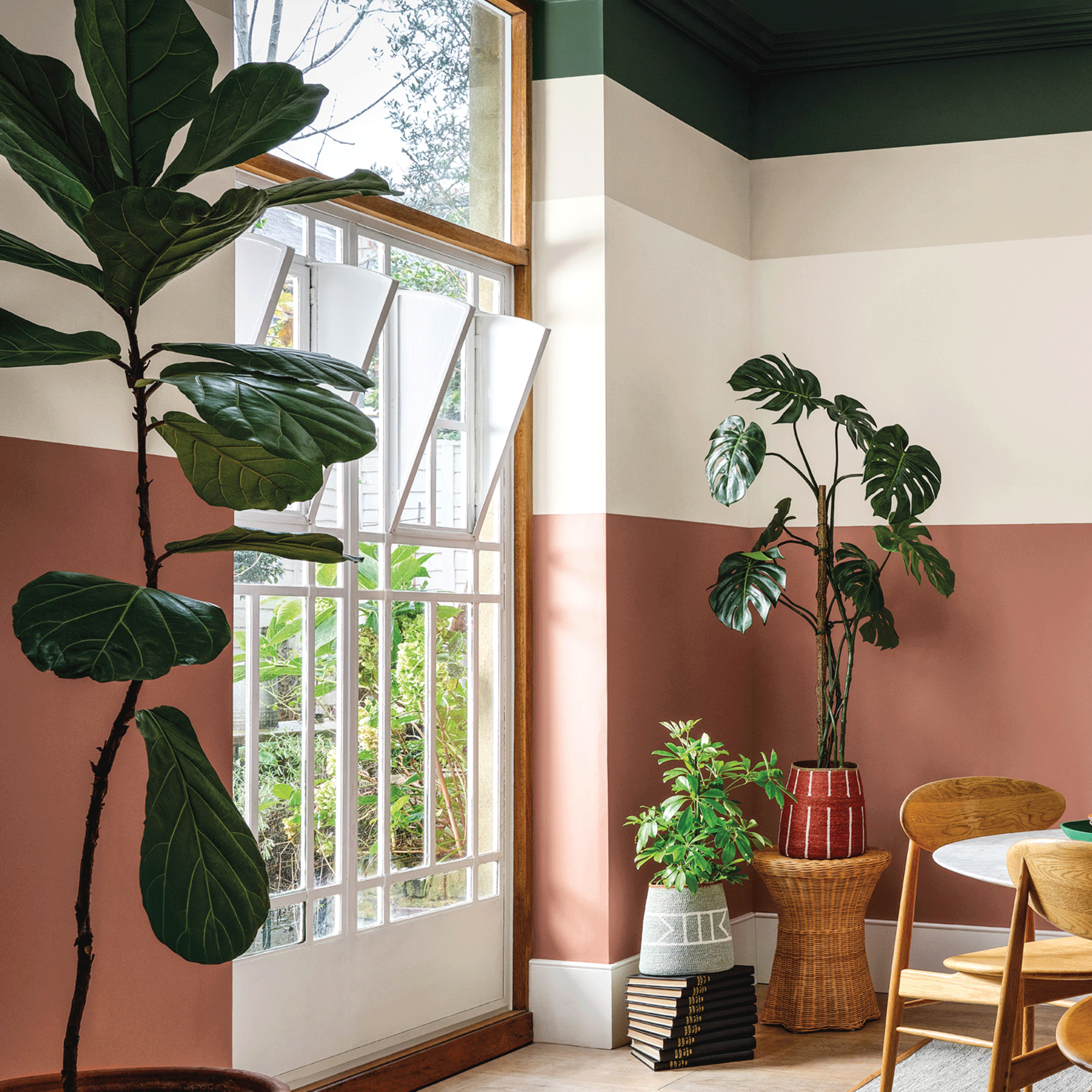 Crown Paint has launched new wall colours for the first time in three years, and changed how I think about neutral shades
Crown Paint has launched new wall colours for the first time in three years, and changed how I think about neutral shadesIs terracotta the ultimate neutral?
By Rebecca Knight
-
 How to protect seedlings from birds – experts say there's a kind and clever way to stop them pecking
How to protect seedlings from birds – experts say there's a kind and clever way to stop them peckingYes, you can protect seedlings from birds without harming your feathered friends...
By Kayleigh Dray
-
 We tried the viral napkin bunny ears hack – it only takes five minutes and will take your Easter table to the next level
We tried the viral napkin bunny ears hack – it only takes five minutes and will take your Easter table to the next levelThis Easter craft is not only beautiful, but really easy to do
By Kezia Reynolds